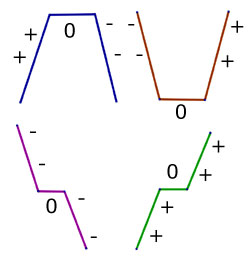Home >> PURE MATHS, Differential Calculus, differential equations
Definition |
Definition
An equation containing any differential coefficients (shown below) is called a differential equation.

The solution of a differential equation is an equation relating x and y and containing no differential coefficients.
General & Particular Solution
The General Solution includes some unknown constant in the solution of a differential equation.
When some data is given, say the coordinates of a point, then a Particular Solution can be formed.
In this example the difference between the two solutions is self evident.

Example #1 

Example #2 

Points of Inflection(Inflexion)
The value of the second derivative can give an indication whether at a point a function has a maximum, minimum or an inflection.
These are all called stationary points.

A point of inflection has a zero gradient, where the point is not a maximum or a minimum value.

The point is where the gradient of a curve decreases(or increases) to zero before increasing(or decreasing) again.
Example
Find the stationary points of the function: ![]()

[ About ] [ FAQ ] [ Links ] [ Terms & Conditions ] [ Privacy ] [ Site Map ] [ Contact ]
